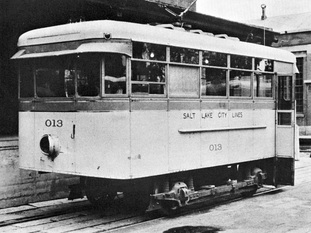| |  Perhaps more importantly, do you believe such a car, coming by on a regular basis, could be a catalyst to economic development? I’ll admit to being a romantic when it comes to trains. When Salt Lake Mayor Ralph Becker came to the Deseret News editorial board the other day to talk about the new trolley line under construction into the Sugar House district, my mind wandered to visions of the early 20th century, with guys in stiff collars and bowler hats running gingerly to hop onto a passing car. I ride the light rail to work and home again every day, even though I have to change trains in the process and the whole trip takes longer than it would in a car (provided the freeways are clear). I enjoy the time to relax, read or answer emails. I probably will ride the trolley to Sugar House occasionally, to go to lunch or do some shopping. But I’m a skeptic when it comes to the claims that rail leads to economic development. I haven’t seen it with light rail, despite hearing lots of bureaucrats predict it for 13 years now. And as for the trolley line — Sugar House already is a vibrant shopping area, but there are lots of spaces between there and where the line will begin, at the TRAX station on 2100 South, that aren’t so pedestrian friendly. Becker and his staff say I’ll need to be patient, but that economic development will come to those areas, too, with walkable shops, restaurants and homes. I’ll remain a skeptic until I see it, albeit a hopeful one. The first phase of the new trolley line will cost $55 million. Only $11 million will come from Salt Lake City, with the same coming from South Salt Lake, through which the line will go. The rest comes from the feds. Becker said nine private-sector projects already are underway in Sugar House worth about a combined $400 million, and that South Salt Lake has some of its own. Meanwhile, look at this old map of Salt Lake City trolley lines during their heyday, probably about 100 years ago. Virtually every home in the city was no more than a block or two from a line. Then look at this report I found from 1977, by the Utah Economic and Business Review, about why that heyday disappeared. Simply put, the automobile came along and got popular. The report concludes that transit programs in the future should avoid “Fixed operating systems which do not provide operating flexibility.” These, it said, would cost a lot of money “without meeting the service needs of the public.” Times change, and 35-year-old conclusions can look wrong in a hurry. As I said, I’m a fan of rail. I think trolleys could add value to an already popular district. But until I see some real rail-specific economic development pop up in other areas, I remain a skeptic of those claims. |
|
0 Comments
Your comment will be posted after it is approved.
Leave a Reply. |
Search this siteLike what you read here? Please subscribe below, and we'll let you know when there is a new opinion.
The author
Jay Evensen is the Opinion Editor of the Deseret News. He has more than 40 years experience as a reporter, editor and editorial writer in Oklahoma, New York City, Las Vegas and Salt Lake City. He also has been an adjunct journalism professor at Brigham Young and Weber State universities. Archives
July 2024
Categories
All
Links
|


 RSS Feed
RSS Feed

